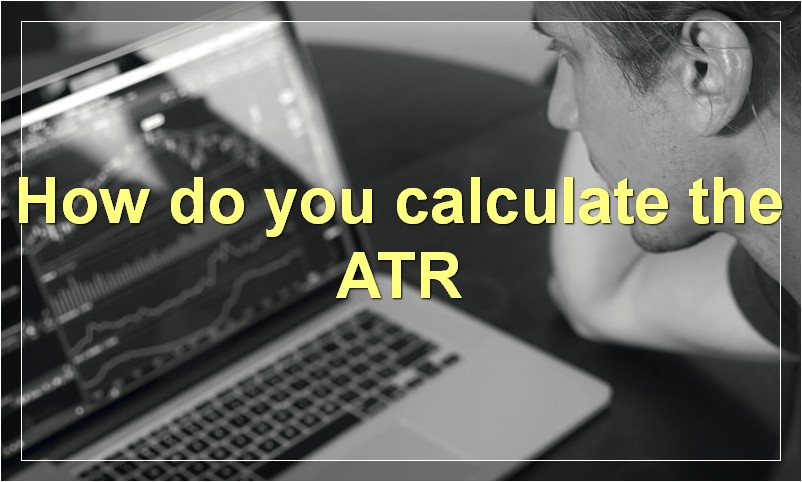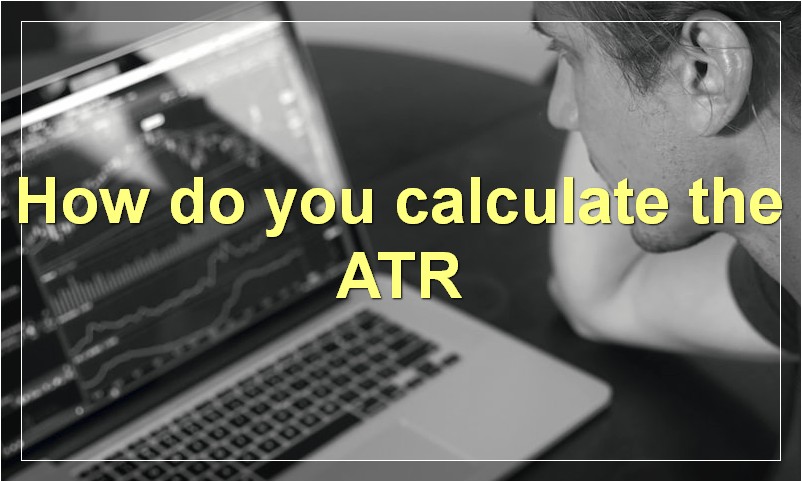Are you tired of feeling like you’re not good enough? Are you ready to take your life back? Then keep reading.
What is the ATR
The Average True Range is one of the most popular technical indicators around. It was created by J. Welles Wilder and introduced in his 1978 book, New Concepts in Technical Trading Systems. The ATR measures how much an asset has moved, on average, over a given period of time. It’s a simple calculation that uses market price data to help traders make better decisions.
The Average True Range is calculated as the average of the true ranges over a specified period. The true range is the greatest of the following:
· The current high minus the current low
· The absolute value of the current high minus the previous close
· The absolute value of the current low minus the previous close
Wilder originally suggested a 14-period ATR, but many traders use different time periods, depending on their trading style and preferences. A longer ATR period will smooth out the volatility, making it less sensitive to short-term price movements. A shorter ATR period will be more responsive to changes in market conditions.
The ATR can be used in a number of ways, but one of the most common is to help set stop-loss levels. For example, if you’re buying a stock, you might use the ATR to help determine where to place your stop-loss order. If the ATR is $2 and you’re willing to risk $100 on the trade, you would place your stop $200 below your entry price. This way, even if the stock hits a short-term snag, you have a good chance of exiting your position before it becomes a big loss.
The ATR is also often used as a trailing stop. In this case, instead of placing a static stop-loss order at a certain dollar amount below your entry price, you would adjust your stop based on the ATR. So, if the ATR is $2 and you want to use a trailing stop, you would move your stop up $2 for every day that the stock goes up. This allows you to lock in profits as the stock moves in your favor while still giving it room to breathe.
There are many other ways to use the ATR, but these are two of the most common. If you’re interested in learning more about this indicator or others like it, check out our Technical Indicators course.
How do you calculate the ATR

How do you calculate the ATR?
The average true range (ATR) is a technical indicator that measures market volatility. It was created by J. Welles Wilder Jr. in his 1978 book, New Concepts in Technical Trading Systems.
To calculate the ATR, you need to first find the true range for each period. The true range is the greatest of the following:
Current high – current low
Current high – previous close
Previous close – current low
Once you have the true range values for each period, you can then calculate the ATR as the moving average of those values.
What is the ATR used for
The ATR is most commonly used as a volatility indicator. It was developed by J. Welles Wilder Jr. and introduced in his book, “New Concepts in Technical Trading Systems”. The ATR measures the distance between a security’s current price and its price at a specific time period in the past. The ATR uses a simple formula that takes the average of the difference between the high and the low over a given period of time.
What timeframes are used to calculate the ATR
The average true range (ATR) is a technical analysis indicator that measures market volatility by decomposing the entire range of an asset price for that period. ATR does not provide direction or predict trend movements. It only indicates how much the price fluctuates.
There are three timeframes typically used to calculate ATR:
– 14 days
– 9 days
– n-day, where n is the number of trading days in a given period
What is the difference between the ATR and other volatility indicators
ATR is a volatility indicator that measures the range of an asset’s price movements over a given period of time. Unlike other volatility indicators, ATR does not provide directional information or make predictions about future price movements. Instead, it simply indicates how much an asset’s price has fluctuated over a given period of time. ATR can be used to measure the volatility of any asset, including stocks, commodities, currencies, and even indexes.
ATR is a popular indicator among traders and investors because it is simple to use and interpret. ATR can be used to set stop-loss orders, identify potential breakout opportunities, and make trend-following decisions. Many traders also use ATR to help manage risk by scaling their position sizes according to the level of volatility in the market.
While ATR is a helpful indicator, it is important to remember that it is only a measure of historical volatility and does not predict future price movements. Volatility is often mean-reverting, which means that periods of high volatility are often followed by periods of low volatility (and vice versa). As such, traders should always use ATR in conjunction with other technical indicators and fundamental analysis to make informed trading decisions.
How can ATR help traders find profitable entries and exits

ATR can help traders find profitable entries and exits by providing them with information about the average true range of a security. This metric measures the volatility of a security, which can be used to gauge how much risk is associated with trading it. ATR can also be used to identify potential support and resistance levels, as well as trend direction. By analyzing these factors, traders can make more informed decisions about when to enter and exit trades.
What are some common misconceptions about the ATR
There are a few common misconceptions about the ATR. The first is that it is only for people who are looking to get in shape or lose weight. This is not true! The ATR can be used by anyone, regardless of their fitness level or weight. It is a great way to get active and have fun!
Another misconception about the ATR is that it is only for people who are looking to tone their bodies. Again, this is not true! The ATR can be used by anyone, regardless of their fitness goals. It is a great way to get active and have fun!
The last misconception about the ATR is that it is only for people who are looking to improve their cardiovascular health. While the ATR is great for heart health, it can also be used by anyone, regardless of their fitness goals. It is a great way to get active and have fun!
How can ATR be used in conjunction with other technical indicators
ATR can be used in conjunction with other technical indicators to provide a more complete picture of market activity. For example, ATR can be used to confirm trends identified by other indicators, or to identify potential reversals. ATR can also be used to set stop-loss levels, or to determine optimal entry and exit points. By considering ATR alongside other technical indicators, traders can gain a more comprehensive understanding of market conditions and better position themselves to make informed trading decisions.
What are some common mistakes traders make when using the ATR
When it comes to using the Average True Range indicator, or ATR, there are a few common mistakes that traders often make. Here are a few of the most frequent offenders:
1. Not factoring in the time frame
One of the most important things to remember when using the ATR is that it is highly dependent on the time frame you are using. A shorter time frame will produce a smaller ATR value, while a longer time frame will produce a larger ATR value. This is important to keep in mind when setting your stop loss levels, as you don’t want to set them too close to the current price or too far away.
2. Not accounting for volatility
Another mistake traders make is not accounting for volatility when using the ATR. Just because the ATR is currently low doesn’t mean that volatility won’t pick up in the future. Conversely, just because the ATR is currently high doesn’t mean that volatility won’t subside. As such, it’s important to always be aware of current market conditions and factor them into your trading decisions.
3. Ignoring price action
Last but not least, many traders make the mistake of ignoring price action altogether when using the ATR. Just because the ATR says a certain level is support or resistance doesn’t mean that price will necessarily obey. As with any technical indicator, the ATR should be used in conjunction with other forms of analysis, such as price action, Fibonacci levels, and trend lines.
Is the ATR a reliable indicator on its own, or does it need to be used in conjunction with other technical indicators
The ATR is a technical indicator that measures the average range of an asset over a given time period. The ATR is considered to be a reliable indicator on its own, as it can provide valuable information about an asset’s price movement. However, some traders may choose to use the ATR in conjunction with other technical indicators, in order to get a more complete picture of the market.

